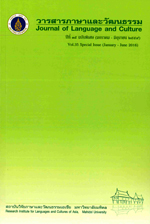Distinctive verbs of Thai teenagers' speech
Main Article Content
Abstract
A verb is a basic and the most important word class in human languages. People of different ages may select different verbs to express their thoughts. Age is one of the important factors for language variations. The researcher noticed that Thai teenagers tend to create new words to be used among themselves. The word originated as a noun referring to "angels" is commonly used by teenagers as a verb “to excel at something” as in (1)
(1)
She keen computer CL one in classroom
“She's the only one who is really keen on computer in the classroom.”
This article aims to: 1) analyze the verbs that represent characteristics of teenagers; 2) examine the distinctive verb constructions used by Thai teenagers; and 3) analyze notable features of the language construction of Thai teenagers. The data were collected from 30 teenagers, aged 11-22 years, who use standard Thai in their everyday lives.
The results reveal 1) the 20 verbs solely used by teenagers; 2) 5 kinds of word formation: clipping, borrowing, compounding, functional shift, and semantic extension; and 3) the exclusive teenagers' serial verb pattern, called "Expressive SVC". This SVC is found to violate the serial verb construction rules by having a stative verbs in the second or third position of SVC, as shown in (2). This new verb pattern mostly relates to their physical appearance which reflects how important teenagers feels about appearance.
(2)
She walk fat (aspect) Siam
“She walked fat in Siam.”
Article Details
The articles featured in the Journal of Language and Culture (JLC) constitute academic works representing the viewpoints of the respective author(s). It is crucial to note that these opinions do not necessarily reflect those of the Editorial Board.
All articles published in JLC are released under the Creative Commons Attribution 4.0 International License (CC BY 4.0). This license grants permission for unrestricted use, distribution, and reproduction in any medium, provided proper credit is given to the original author(s) and the source.
References
Hudson,R. (2007). Language networks: Thenew word grammar. Oxford University Press.
Shoichi, I, & Ingkaphirom, P. (2005). A reference grammar of Thai. Cambridge: Cambridge University Press.
Labov, W. (1972). Sociolinguistics patterns. Philadelphia: University of Pennsylvania Press and Oxford.
Lakoff. G. & Johnson. M. (1980). Metaphor we live by. Chicago and London: The University of Chicago Press.
Matisoff, J. (1973).The grammar of Lahu. University of California Publications in Linguistics.
Starosta, S. (1988).The case for lexicase: An outline of lexicase grammatical theory. London:Printer Pup Ltd.
John,S. (1997). Semantics. New York: Cambridge University Press.
Yule, G. (2006). The study of language. (3rd Edition). New York: Cambridge University Press.


